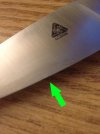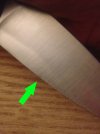-
The BladeForums.com 2024 Traditional Knife is ready to order! See this thread for details: https://www.bladeforums.com/threads/bladeforums-2024-traditional-knife.2003187/
Price is$300$250 ea (shipped within CONUS). If you live outside the US, I will contact you after your order for extra shipping charges.
Order here: https://www.bladeforums.com/help/2024-traditional/ - Order as many as you like, we have plenty.
You are using an out of date browser. It may not display this or other websites correctly.
You should upgrade or use an alternative browser.
You should upgrade or use an alternative browser.
LC200n serrated has rolled need a field fix
- Thread starter S-3 ranch
- Start date
- Joined
- Mar 8, 2008
- Messages
- 26,086
See if you can find something hard you can use to apply pressure to the roll to straighten it back out.
- Joined
- Apr 15, 2012
- Messages
- 1,104
A friend rolled an edge on a big chopper a few days ago in the field. I used the back side on needle nose pliers (rounded, hardened piece of steel) of my OG Leatherman to straighten the roll just like using a butchers steel.
As FortyTwoBlades commented above;
Any hardened steel with a rounded profile (screw driver, etc., etc.) could be used to re-align the roll in the field to get ya through the day.
As FortyTwoBlades commented above;
Any hardened steel with a rounded profile (screw driver, etc., etc.) could be used to re-align the roll in the field to get ya through the day.
I sometimes use the shank of a 1/2” drill bit like a burnishing steel.
The way I picture your serrated blade, I suspect the lower 1/4 or 1/3 of the teeth are doing almost all the cutting. When you straighten the roll, it’ll weaken the bent part. You’ll probably end up removing the serrations and having a plain edge blade eventually.
Parker
The way I picture your serrated blade, I suspect the lower 1/4 or 1/3 of the teeth are doing almost all the cutting. When you straighten the roll, it’ll weaken the bent part. You’ll probably end up removing the serrations and having a plain edge blade eventually.
Parker
Last edited:
I wi
l will probably need to send to spyderco to get it fixed, can’t figure it out how soft plastic rolled LC200n?I sometimes use the shank of a 1/2” drill bit like a burnishing steel.
The way I picture your serrated blade, I suspect the lower 1/4 or 1/3 of the teeth are doing almost all the cutting. When you straighten the roll, it’ll weaken the bent part. You’ll probably end up removing the serrations and having a plain edge blade eventually.
Parker
- Joined
- Apr 15, 2012
- Messages
- 1,104
l will probably need to send to spyderco to get it fixed, can’t figure it out how soft plastic rolled LC200n?
I believe the black plastic you are referencing has a Shore A Hardness rating of 100, which is actually pretty high. Plastic zip-ties (similar hardness) are well known for rolling and/or chipping knife edges (via side-load stress during a cut). Spyderco serrated edges are typically relatively thin behind the edge, making that area more prone to damage from side loading.
My guess, the area of the edge that rolled had high side-load applied (in excess of the elastic modulus of the steel) during a cut resulting in rolled edge referenced in OP.
If you are interested in this side-loading issue as related to knife steel, suggest a review of link below (Edge Stability) for various explanations as to the how & why.
Edge Stability
Additionally, there is now a Part#2 at the bottom of the linked page above ;-)
EDIT:
Below, from a long trusted Spyderco forum member when it comes to corrosion resistant Spyderco steels.
 H1 vs. LC200n...Real World Observations
H1 vs. LC200n...Real World Observations
Postby Surfingringo » Fri Jul 27, 2018 10:04 amQuote from Surfingringo
"It should also be noted that the weakest point of LC200n’s performance is actually the same as H1’s…a lack of strength. I have found that my lc200n edges will also roll under high pressure/hard media.
Last edited:
- Joined
- Mar 8, 2008
- Messages
- 26,086
^^^Yup. This. Side loads on resistant materials are the culprit typically. Especially if the blade rocks or twists while the very apex is embedded in the material.
Yes probably to much side load, I do cut lots of zip ties , weird ropes, and salt and Ivermec blocks in cardboard with plastic bands, even chest bones on deer and hogs , my moraknif serrated seems to hold up better with different serrationsI believe the black plastic you are referencing has a Shore A Hardness rating of 100, which is actually pretty high. Plastic zip-ties (similar hardness) are well known for rolling and/or chipping knife edges (via side-load stress during a cut). Spyderco serrated edges are typically relatively thin behind the edge, making that area more prone to damage from side loading.
My guess, the area of the edge that rolled had high side-load applied (in excess of the elastic modulus of the steel) during a cut resulting in rolled edge referenced in OP.
If you are interested in this side-loading issue as related to knife steel, suggest a review of link below (Edge Stability) for various explanations as to the how & why.
Edge Stability
Additionally, there is now a Part#2 at the bottom of the linked page above ;-)
EDIT:
Below, from a long trusted Spyderco forum member when it comes to corrosion resistant Spyderco steels.
Postby Surfingringo » Fri Jul 27, 2018 10:04 am
H1 vs. LC200n...Real World Observations
Quote from Surfingringo
"It should also be noted that the weakest point of LC200n’s performance is actually the same as H1’s…a lack of strength. I have found that my lc200n edges will also roll under high pressure/hard media.
- Joined
- Jul 23, 2015
- Messages
- 17,856
I have a near zero ground EDC knife in .084" LC200N. Absolute laserlike cutting. I cut up a hard plastic cat toy (a hard plastic rod with a length of string and feathers/bell at the end) and rolled my edge. I was not surprised given the high force I had to apply and the certainty that my angle was not perfectly perpendicular. It was hardened to 60 RC. I knew before I went through with it that it was a stretch to put the knife through such a task, given the extreme geometry. I did it partly just to see what would happen. I made about half a dozen cuts, pressing straight down onto the rod against my bamboo cutting board for all but one cut. That one, ill-advised cut, involved bending the roc around the knife and pulling through with the edge, and I am pretty sure that is what caused the most deformation. Anyway, despite that very small roll that I decided to hone out instead of bend back, the knife made easy work of the cat toy. My experience is such that I would not have dreamed of making this cut if the knife were S30V or S110V, for fear of chipping at this thinness, or simply not getting through the plastic if they were more appropriately (for the alloy) thicker behind the edge. All just in my opinion.
Here is what it looks like now after a bit of work on the brown, then white rods of the Sharpmaker.


The apex isn't perfectly straight, but the deviation is so minimal noobdy will pick it out unless they are really looking for it, and it is still a laser for my uses, which are cardboard, mostly, and cutting worn belts to fit in the waste.
Here is what it looks like now after a bit of work on the brown, then white rods of the Sharpmaker.


The apex isn't perfectly straight, but the deviation is so minimal noobdy will pick it out unless they are really looking for it, and it is still a laser for my uses, which are cardboard, mostly, and cutting worn belts to fit in the waste.
